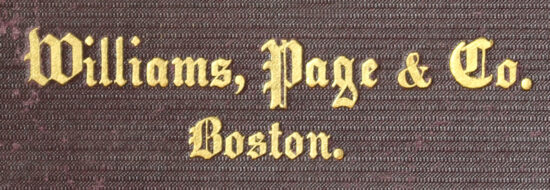
Overview
This smaller manufacturer specialized in the production of railroad lamps, dedicating their craftsmanship to both passenger car and locomotive lighting, with limited diversification into nautical lamps and, intriguingly, hurricane lamps, possibly in the tubular lantern style.
The ownership trio, P.S. Page, D.S. Page, and T.S. Williams, held a handful of patents for innovative lamp designs that set them apart from competitors such as Adams & Westlake, Post & Company, and Dayton Manufacturing. Notably, these patents featured contributions from an additional designer, Freeman Agustus Taber, although the catalog and lamp markings omitted acknowledgment. Taber's creation evolved into the Williams, Page & Company Model #14, a popular Railway Post Office Wall Lamp (and the same patent was used for chandeliers.)
Within the Kirkman Collection resides an early Williams, Page & Company catalog, serving as a valuable reference for understanding their diverse offerings. This archival gem showcases an array of wall lamps, ceiling lamps, and chandeliers. Among the three names listed as owners of the company, T.S. Williams is notably absent, while R.E. Williams, presumably his son, is included. This information, combined with details provided below, supports the inference that this catalog likely dates back to 1878-'79.
In my personal collection, I've dedicated efforts to amassing a variety of these lamps, aiming for completeness by acquiring each size of lamp, each model of lamp, and each aesthetic difference. Notably, I've even secured examples in various finishes, such as an olive green lacquer with gold bands and a steel finish adorned with gold bands. Interestingly, the catalog does not explicitly mention the availability of these color options, adding an element of mystery to these finely crafted lamps. Often these lamps, when they turn up with an original finish, are done in "Ormolu" A Gold Applied finish using mercury to first dissolve the gold. The liquid is applied to the surface of the metal base, and the mercury is baked off in an oven, at temperatures above the melting point of typical solders. This is why a majority of Williams & Page work is cold riveted together, solder would otherwise melt in their ovens and the lamps fall apart. The company couldn't completely get away from soldered construction, and would often soldered in a tin steel plate into the bottom of the lamps that held a brass female coupling, and a steel rod. The bottom finial of their lamps would usually hold the bottom cap of these lamps in place, as it also wasn't soldered on.
"The firm of Williams, Page & Co., of Boston, which was organized as dealers in general railway supplies nearly thirty years ago, claims' to have invented and manufactured the first car lamps for burning kerosene or mineral oils, and the first hanging lamps for Monitor cars"
Old Photos of Their Lamps
Getting into Production Took Longer Than Expected.
Thomas S. Williams and Phillip S. Page Patented a Lamp idea in 1863, but it appears that during the Civil War, they remained as brokers of Railway Supplies, and did not start working to produce lamps until 1869 or so. As a result of not being able to use their patent effectively for the first 5 years of it's protected use, it appears the Patent Office offered a Reissue of the patent in 1869, allowing the company to produce the protected designs for longer.
Owners over the Years
Thomas Scott Williams :
"Thomas Scott Williams of Boston, born January 20, 1814, son of Solomon and Martha (Baker) Williams of Manchester, Conn., a grandson of Rev. Solomon Williams, D.D., of Lebanon, Conn. He was a civil engineer, and afterwards engaged in the business of railroad supplies in Boston, firm of Williams & Page. He died at Somerville, Mass., December 29, 1874, aged 62"
Wife of T.S. Williams: Ellen, born July 2, 1819; married, October 7, 1846,''
Child #1
Robert Edwards Williams, born January 27, 1849, in Newton, Mass.; Yale College, 1871; University of Michigan, 1874, degree of Civil Engineer; employed at the water-works in Lawrence and Newton, Mass., 1875-76; married, April 26, 1877, Helen E., dau. of Hon. W. L. Seaton of Jackson, Mich.; was connected with the firm of Williams, Page & Co., manufacturers of railroad supplies, Boston, six years; then lived for a time in Hartford, Conn., being connected with the firm of J. B. Williams & Co., Glastonbury ; then removed to Jackson, where he died May 16, 1887
{Reportedly only member of Williams Page & Company 2 years 1878'-79 as per The Michigan University Book. 1814-1880 }
OBITUARY.
ROBERT EDWARD WILLIAMS, son of Thomas Scott and Ellen Goodwin Williams, was born in Newton, Mass., Januatry 27, 1849. He graduated at Yale, in 1871, and took up Civil Engineering as a profession, and, after two years' practice, entered the University of Michigan to complete his studies He graduated in 1874, with the degree of Civil Engineer, and for the next year and a half was employed at the water- works in Lawrence, Mass. He then entered the firm of Williams, Page & Co., of Boston, dealers in Railroad Supplies, with which he was connected about six years. He was married April 26, 1877, to Miss Helen ^., daughter of Hon. W. L. Seaton, of Jackson, Mich., and made that place his residence during his later years. While engaged as Superintendent of the Construction of Water-works in Rochester, Minn., in 1886-7, his health failed and he was obliged to resign.
The immediate cause of his death, which occurred May 16, 1887, was congestion of the lungs. His wife, one son and one daughter survive him."
Obituary in Michigan Engineer Society
Child #2
Annie Goodwin Williams, born 1878, now {1905 when work was published} living in Boston, engaged in kindergarten work ; 2, Robert Seaton, born July, 1880, in Hartford, Conn. ; grad. Institute of Technology, Boston, 1902 ; now an instructor in the Institute.
Child #3
Mary Goodwin Williams, born March 26, 1851; died in Auburndale, November 5, 1864.
Child #4
Mary Edwards Williams, born January 22, 1853 ; living in Auburndale, unmarried.
Child #5
Annie Huntington Williams, b. August 3, 1856 ; married, September 5, 1883, Joseph F. Ryder of Auburndale
Child #6
Ellen Constance Williams, born March 10, 1859; living in Auburndale, unmarried.
The genealogy of the descendants of Henry Kingsbury, of Ipswich and Haverhill, Mass.
I am still researching the Page Family, not much history or genealogical information can be found about them.
| US38620A | Williams & Page | 5/19/1863 | Improvement in Lamps for Railway-Cars | |
| USRE2678E | Williams & Page | 7/9/1867 | Improvement in lamps | |
| US66635A | W. Robinson | 7/3/1868 | Lamp Burner | |
| US103534A | Williams & Taber | 5/24/1870 | Treatment of Wicks | |
| US103388A | F.A.Taber | 5/24/1870 | Manufacture of Tubular Wicks | |
| US103810A | Williams & Taber | 5/31/1870 | Improvement in candlelamps | |
| US105020A | Williams & Taber | 7/5/1870 | Improvement in candle-lamps | |
| US104525A | Williams & Taber | 6/21/1871 | Improvement in lamp for burning candles | |
| US123803A | Martin Weis | 2/20/1872 | Candle Lamp or Holder | |
| US148903A | F.A.Taber | 3/24/1874 | Improvement in lamps | |
| US169497A | F.A.Taber | 10/2/1875 | Lamp | |
| US171638A | F.A.Taber | 12/28/1875 | Lamp Burner | |
| US176563A | F.A.Taber | 4/25/1876 | Improvement in lamp attachments | |
| US214470A | F.A.Taber | 4/15/1879 | Improvement in lamps - Latching mechanism | |
| US236108A | F.A.Taber | 12/28/1880 | Lamp | |
| US244407A | F.A.Taber | 7/19/1881 | Lamp | |
| US349186A | F.A.Taber | 9/14/1886 | Lamp-holder for car and other lamps | |
| US89811A | F.A.Taber | 5/4/1869 | Candlestick | |
| USRE9801E | F.A.Taber | 7/12/1881 | Lamp | |
| US278373A | F.A.Taber | 5/29/1883 | Lamp | |
| US103388A | F.A.Taber | 5/24/1870 | Manufacter of Tubular Candles |
Williams, Page & Co made the first Chandelier to ever be Electrified (by Edison)
The Evolution of Electric Lighting Fixtures.
[A paper read by R. M. Dyer, before the National Association of Gas and Electric Fixture Dealers. }
"To a manufacturer or dealer who entered the business after the present constructions had become standard, and without knowledge of the travail which preceded that result, electric and combination pendants appear to be only the ordinary gas fixtures with the wires and insulating joints added, and with such simple changes in construction as are required to accommodate these conditions. Back of this, however, there is a history which has never been and probably never will be fully written, and which is known only in part to those few manufacturers and dealers who participated in the early introduction of the incandescent electric lamp.
That lamp was invented by Mr. Edison in the summer and fall of 1879, and was publicly exhibited in operation on a considerable scale at Menlo Park, N.J., during the Christmas holidays of that year. The exploitation of this lamps a substitute for gas for interior illumination was undertaken by The Edison Electric Light Company. During the year 1880 the only plant worth noting was that on the steamboat ‘*Columbia,” of the Oregon Navigation Company, plying between Portland, Oregon, and San Francisco, Cal. This boat had oil fixtures to which were added crude attachments for supporting incandescent lamps. The fixtures were made by Williams, Page & Company, of Boston, Mass. They were special constructions, which have never bee repeated, and which furnish no indications of how to build pendants suitable for general use for the lighting of houses."
Known Locations of the Business
The earliest recorded use of the name "Williams & Page" is from 1858 in the The Massachusetts Register, and were located at 44 Water Street.
Williams, Page & Co. Offices are first noted in the Boston Directory in 1863 at 67 Water Street and then 91 Water Street in 1864. Both buildings have been torn down and rebuilt.
In 1872 they relocated to 104 Sudbury Street (1873 Boston Directory). This whole area has been redeveloped, few streets appear to even share an alignment with streets of then same name on a Sanborn Map, so I must estimated the 104 Sudbury address is near this pin.
It appears the address at 91 Water Street was torn down shortly after W&P left as in 1874 the building that currently resides there, was built. The Codman Building at the current address of 91 Water Street appears to have been built in 1874. The other buildings at those current addresses appear to be more modern than the 1880's.
In the 1874 Directory they list their address as 81, 83, and 85 Water Street, same for 1875,
In the 1879 Boston Directory, Williams, Page & Co. have moved to 24-26 Beach Street.
The Numerous Moves might be why W&P were hesitant to put an address on either their lamps or their advertisements.

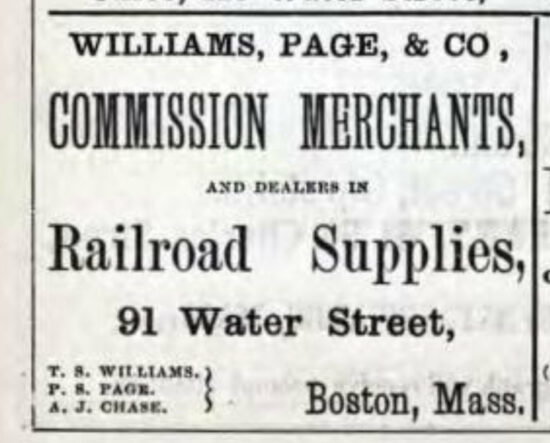

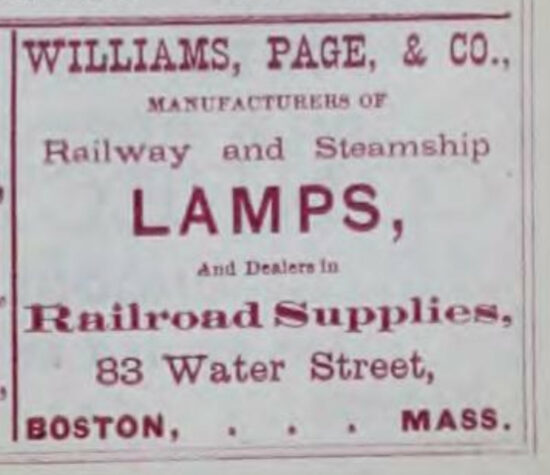
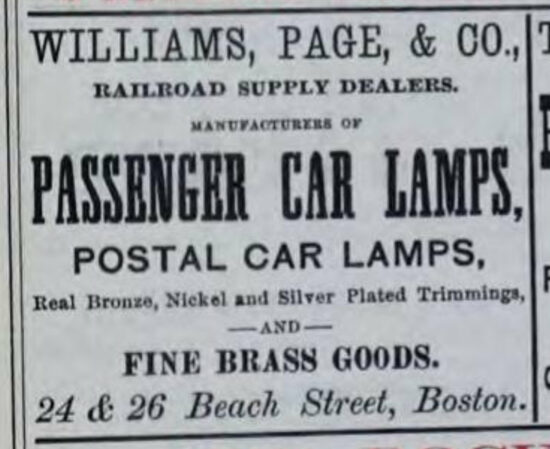
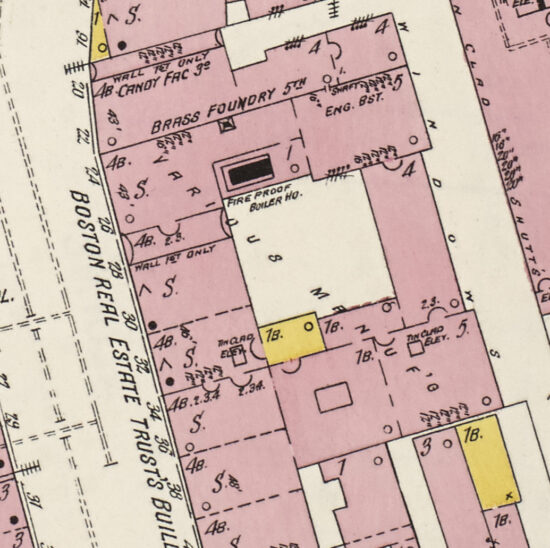
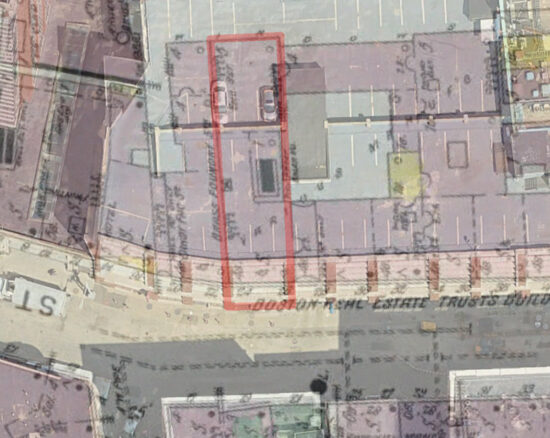
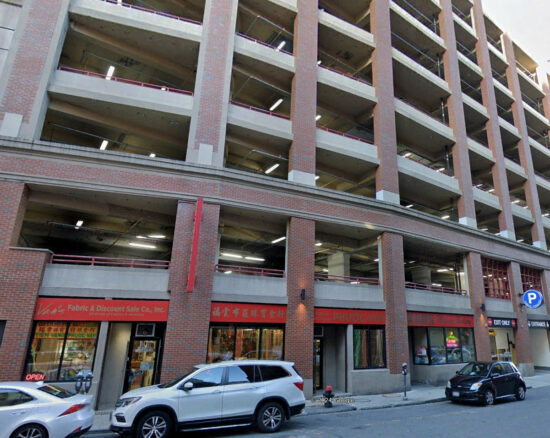

Yet again in 1891 Williams, Page, & Co, now run by the two sons of Page, moves to 227-233 Cambridge St. in Boston.
The building has been torn down, but here is the location today, and in 1895 Sanborn Maps.
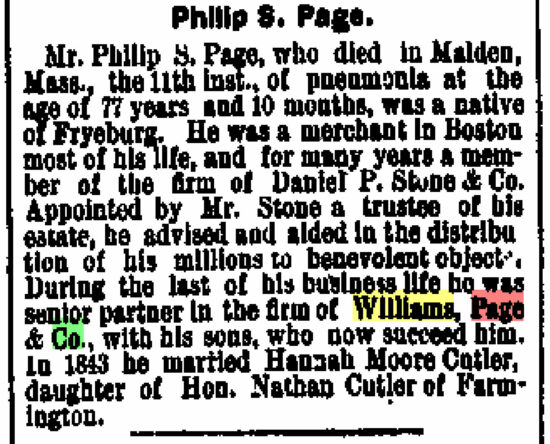
Phillip S. Page no longer part of business in 1889 Boston Directory, and passed away in 1890. Now the business is only run by two suns of Phillip .S. Page as T. S. Williams was no longer named in the business in 1886.

In 1892, the two sons appear to have renamed their business to Page Brothers & Company, as per their advertisement in the Boston Directory.
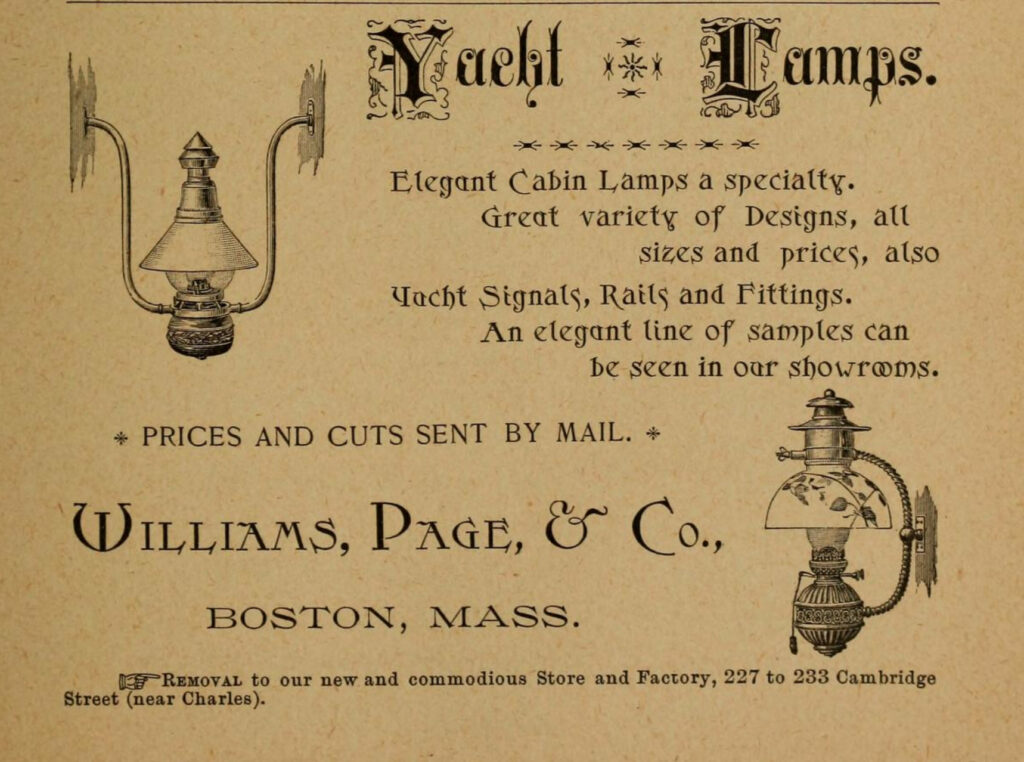
1891 Advertisement in "A History of the Boston Yacht Club"

1893 Boston Directory Advertisement
Sample room and Salesroom only lasts from 1893 to 1894.

In the 1895 Directory, they drop any affiliation to "Williams, Page & Co." and are simple just known as "Page Brothers & Co."

In the 1896-97 they would move from the previous location down the street to 347-357 Cambridge St.
Page Brothers & Company was still in business at that location until at least 1901, but that is when the Boston Directory ends, and I have had no other such way to track the existence of the business.
Badge Dating
Pre-1874
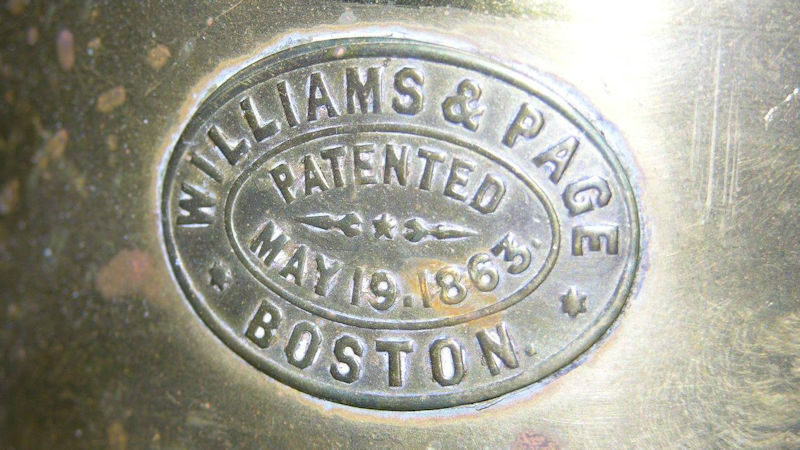
Post-1874 (Williams & Page Boston)
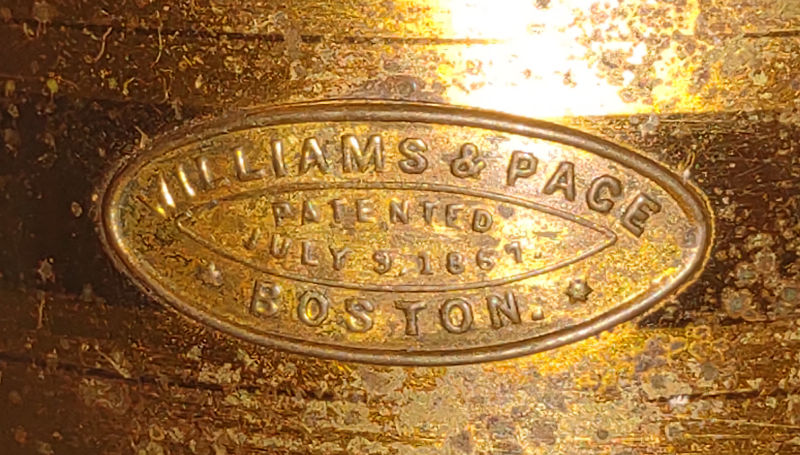
*Lamp in Kirkman Collection
Post-1874 (Williams & Page Boston)
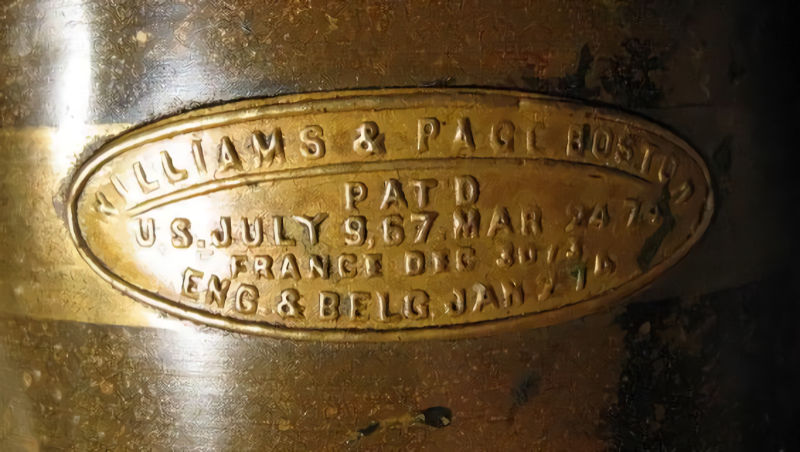
Post-1874 (Williams, Page & Co)
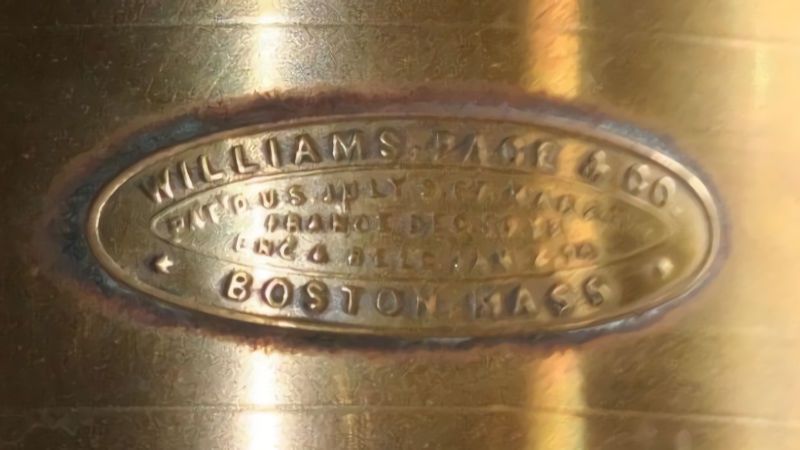
Post-1874 (Williams, Page & Co)
Mounted on a special Wall Lamp of a Taber Patented Design. Patent specifically applies to only this lamp.
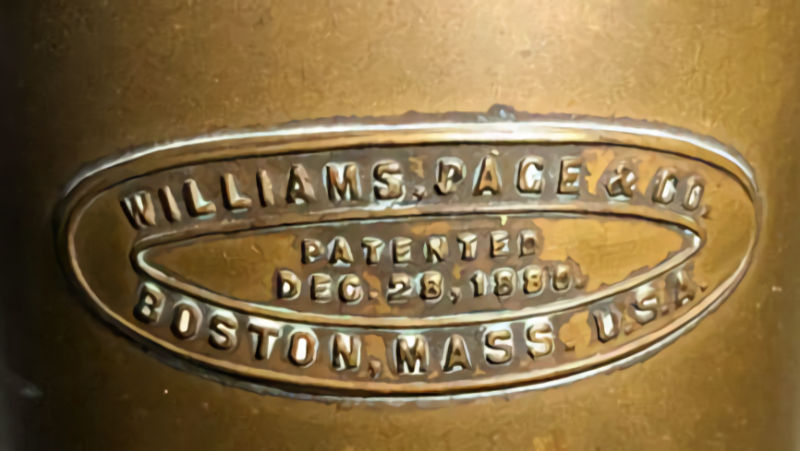
Post-1874 (Williams, Page & Co)
Mounted on a Steel Square Lamp, it didn't utilize a Patent and it shows W.P.&Co. was careful with their markings.

Post-1874 (Williams, Page & Co)
Badge with No Patents mounted on #2 Wall Lamp with Steel on Gold Band Lamp in Kirkman Collection
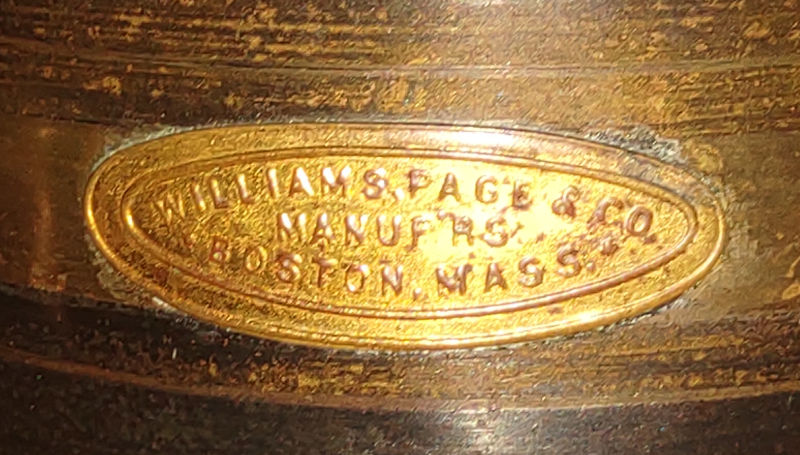
*Lamp in Kirkman Collection
Post-1894 (Page Bros & Co.)
It appears that as the Page Bros Badge is lacking all Patents, it means the loss of their finial 1874 Patent which expired 20 years later (1894) possibly inspired an idea to change the business name as well, as neither the original Page, nor any of the William's family had anything to do with the business at this point in time.

Post-1894 (Page Bros & Co.)
Mounted on a Nickle Plated #2 Wall Lamp with the Special Patented Globe/Shade Holder. Patent Specifically Applies.
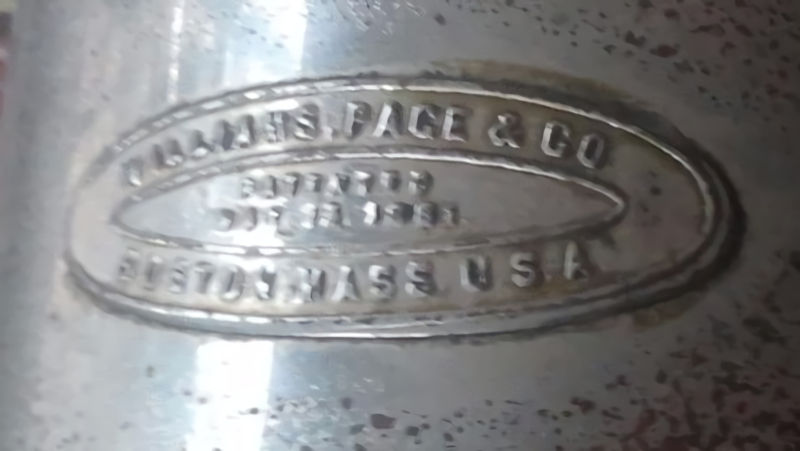
Surviving Lamps
Wall Lamps
#00 Size
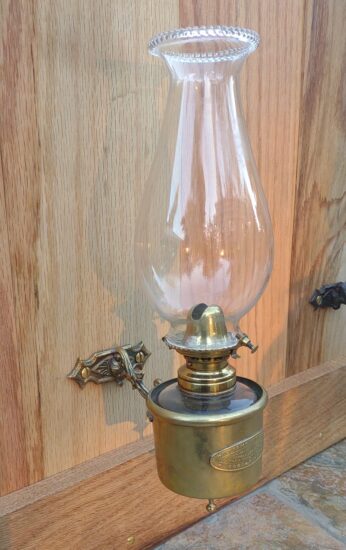
Lamp was found with everything but the chimney. The burner is a special #00 Size Lip Burner that takes a 1 5/8" Lip and a 3/8" Wick. Finding the correct Pearl Top Lip Chimney, likely made by Macbeth Evans Glass was not easy and took a year to find. Now paired together. The Finial on the bottom was also missing but a similar style finial was turned and installed. The Fount is slightly purple as a result of the Magnesium clearing agent.
#0 Size
These lamps are in theory the same as the #00, as the collar is the same, and the lamp fount sizes of the #00 looks like a #0 size when lined up next to a #1 and #2 Wall Fount. It is typically possibly the #00 lamp above should get a #0 burner with a 1/2" wick instead.
#1 Size
I have a #1 Wall Hanger in my collection that takes a 3 1/4 diameter fount, in stead of a 4 1/4" D. Fount like the #2 or a 2 1/2" D. Fount like the #0/00. Working on completing the lamp to display. I could not find photos of any other W&P Lamps of this size.
#2 Size
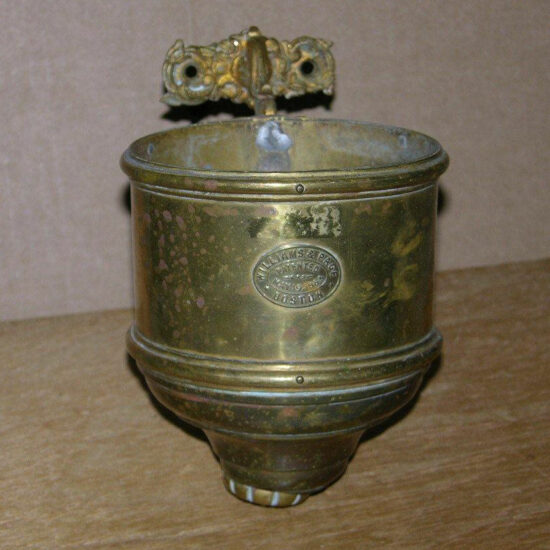
Here's a variety of 1863-1873 early badge #2 Wall Lamps.
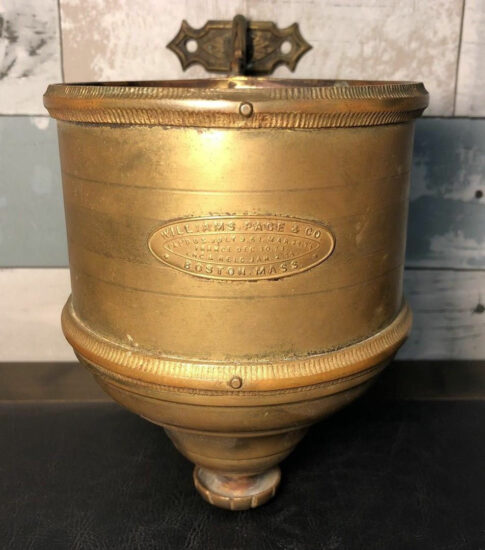
Other Wall Lamps
Nickel Plated #2 Wall Lamp with the W&P Patented Globe Holder. Interesting Design, and also only had 2 screws for mounting despite taking a somewhat heavy globe.
This Lamp was located in the United Kingdom, and was not marked for Williams & Page, however it has their patented design. Unsure it was it made by W&P, Made under contract with their patent, or if someone else produced this, but it's an interesting piece.
Square Lamps (Railroad or Nautical Use?)
Additional Tidbits of Info.
Additional Notes:
1869 Advertisement for Railcars Lamps, Wall Lamps, and Saloon Lamps.
1869 Advertisement for 5 Used Locomotives Available
American Railroad Journal 1869-04-10: Vol 42 Iss 1721
An Allan J. Chase appears to have been a partner around 1870, but was no longer partner by '71.
As the business was growing in the 1870's, the sons of Phillip Page came into the business.
1885 Leading Manufacturers and merchants of the City of Boston : and a Review of the Prominent Exchanges
Nice article talking a bit about their manufacturing capabilities.
In 1887, the Navy spent $2.133.80 on lamps sourced by Williams Page & Company. Annual reports of the Navy Department for the fiscal year .
Charles Sherburne Worked at Williams Page & Company
The book of Boston : fifty years' recollections of the New England metropolis
